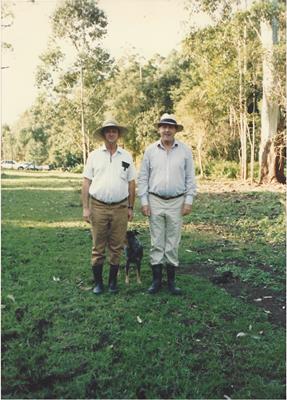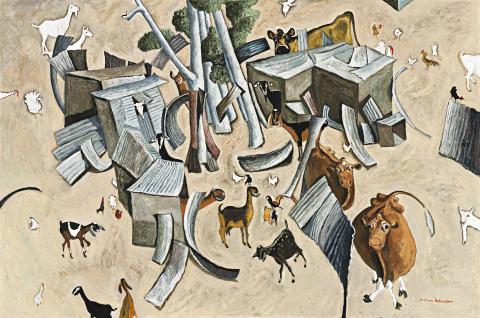BIRKDALE FARM CONSTRUCTION WITH WILLY WAGTAIL, 1983 – 1984
WILLIAM ROBINSON
oil on canvas
121.5 x 182.0 cm
signed lower right: William Robinson
Ray Hughes Gallery, Brisbane
(label attached verso)
The Collection of Colin and Elizabeth Laverty, Sydney, acquired from the above in November 1987
William Robinson – A Retrospective, Queensland Art Gallery, Brisbane, 31 August – 11 November 2001; then touring to: National Gallery of Australia, Canberra, 14 December 2001 – 10 March 2002 (label attached verso)
William Robinson: The Transfigured Landscape, QUT Art Museum and William Robinson Gallery, Brisbane, 16 April – 14 August 2011
Fern, L., William Robinson, Craftsman House, Sydney, 1995, pl. 27, pp. 116 – 117 (illus.)
Sears, L., Darkness and Light, The Art of William Robinson, Queensland Art Gallery, Brisbane, 2001, pl. 20, p. 79 (illus.)
Van Ooyen, V. (et al), William Robinson: The Transfigured Landscape, Queensland University of Technology, Brisbane and Piper Press, Sydney, 2011, p. 110 (illus.)
Bill and Colin.jpg

William Robinson’s farmyard paintings are central to his development as an artist. Not simply because they form a fascinating series in themselves, but because these paintings are fundamental to Robinson’s reconfiguring of the Australian landscape. Birkdale Farm Construction with Willy Wagtail, 1983 – 1984, is one of the major examples which form the core of this important series.
Robinson’s ‘farmyards’ can be seen as microcosms of his world at the time they were created. At times they mischievously reflected the machinations of the Brisbane art scene where the artist lived and worked or the internal politicking of the art school staff room where he worked as a teacher. However, in Birkdale Farm Construction with Willy Wagtail, the overarching theme of the painting is much closer to home. The scene is one of upheaval and possibly reflects what occurs when a family decides to move house, which the Robinsons were in the process of doing around this time. The strewn corrugated iron suggests constant re-arrangement, they may also be seen as stacked boxes, furniture or other belongings haphazardly arranged awaiting the move. The nervous disposition of the cows in particular is central to the mood of the work. Two appear to be hiding and each stare directly back at the artist/farmer as they appear to fret about the impending move.
The regular menagerie of characters is present in the work. The cows, goats, ducks and chooks that combine to make up the composition were probably closer to family pets than anything else and Robinson imbues each with personality. In his own words and with an Orwellian overtone, Robinson’s depictions give ‘… some feeling of the relationship of man to domestic animals and also the relationship that exists within the world of these animals’.1
The Willy Wagtail referred to in the title makes a cameo appearance in the top left. Importantly, the inclusion of this flighty little bird offers us an insight into the artist’s way of seeing the landscape. A bird’s eye view is essentially what we are looking at and the manner in which Robinson draws the viewer’s eye in, around and through the composition parallels to the way the Willy Wagtail might flit around the same scene, resting momentarily at various points as one’s eye does when viewing the painting.
Of course the whimsical nature of Robinson’s farmyards, along with his mischievous innuendo belie the seriousness of these works, for these farmyard paintings are also dissertations on the values of western painting. The primary influence of modern masters such as Cezanne, Braque, Bonnard and Morandi are present and each informs the structure of Robinson farmyard compositions in their own playful way. We can also assume the influence of the Australian artist Ken Whisson, with whom Robinson shared the walls of the Ray Hughes Gallery many times during the 1970s and 80s. Whisson’s robust distortion of pictorial space during the 1970s culminated in freehand, unconventional arrangements which arguably pointed the way for Robinson to lay the groundwork for the farmyard paintings and subsequently the soaring, majestic landscapes for which the artist became well known. This is perhaps one reason that Robinson’s work has hung so comfortably alongside those of Ken Whisson within the Laverty collection over many years.
1. Robinson, W., in conversation with the Gold Coast City Art Gallery, 1998, quoted in Walsh, J., ‘Goats, Cows and Chooks: The Painters Farmyard’, in Seear, L. (ed.), Darkness and Light: The Art of William Robinson, Queensland Art Gallery, Brisbane, 2001, p. 72
